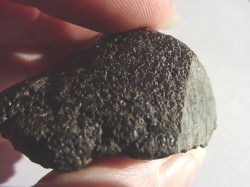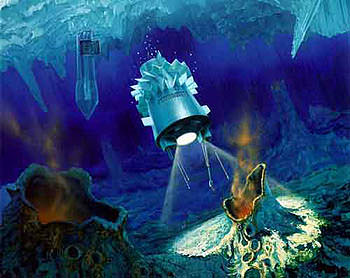The idea that there is life on other worlds is humbling and exciting, and finding life on another world would change everything. This has been a driving force for scientists for decades. We find life wherever we find water on Earth, in pools of boiling water, inside glaciers, even in nuclear reactors.
Because of this, our best candidate for life is probably Mars.
The planet is hostile to life now, but evidence is mounting that it was once a warm and habitable world, with rivers, lakes and oceans. Mars could have vast reserves of subsurface water, where life could thrive even now.
If we did discover life there, it’s possible that it’s completely unrelated to Earth life. This would demonstrate that life can originate on almost any world, with the right conditions.
It’s also possible that life on Mars is related to Earth, and our two planets share a common ancestor billions of years in the past.
This is a theory called panspermia.
It suggests that life on Earth and Mars are connected. That life has been traveling from Mars to Earth and vice-versa for billions of years. “How is this possible?” you might ask.
Meteorites.

We know this is true, because we have meteorites on Earth which originated on Mars. Tiny gaps in the rock contained gases which match the atmosphere of Mars. You would think that an asteroid strike would sterilize life in the rocks, but amazingly, bacterial life can survive this process.
Microbial life can even withstand the harsh temperature, radiation and vacuum of space for thousands – possibly millions of years – riding inside their rocky spacecraft.
Some bacteria could even survive when their “space rock” enters the atmosphere of another world.
So a natural space exploration program has been in place for billions of years, with asteroid strikes hurling life-filled rocks into space, which then smash into other worlds.
Life on Mars has been elusive so far, but there are missions in the works which will have the scientific instruments on board to hunt for life on the Red Planet.

It gets even stranger.
The Solar System is leaving a trail of debris behind as it orbits around the Milky Way, which could be colliding with other star systems. Which means, it’s possible that life around other stars is related to us too.
So maybe there’s no life on Mars, or if there is, maybe it originated on its own, or maybe it’s all related, as a result of trading life back and forth across giant spans of time and space.
Whatever the case, the search sure is going to be exciting.
Additional Info:
Could Curiousity determine if there’s life on Mars?
SOLID clues for finding life on Mars


I still have my doubts about panspermia. It’s possible, but just as likely went from Earth to Mars as Mars to Earth.
I’m more concerned about where life cones from in the first place, and panspermia doesn’t answer that question, it just moves it’s location away from Earth.
A lot can depend on whether it’s easier to get life-bearing rocks from Mars to Earth than from Earth to Mars. My guess is the former.
You need to get a rock to escape the gravity of the planet, which is easier for Mars as it is smaller. Then you need to be captured by the destination planet which Earth can do better than Mars. You also need some mechanism to blast the rocks off the surface, ie. meteor impacts. Mars has the advantage here also, because it is nearer the asteroid belt and therefore has had more frequent impacts. Since the impacts don’t need to be as severe as on Earth to launch a rock, it’s also more likely that rocks escaping Mars can do so with their contents intact.
The only question I have is whether orbital mechanics in the Solar System make it easier for small objects to migrate inwards or outwards, once they’re already in space.
No, what you need to do is to balance likelihoods (in the form of rates) between delivered viable cells vs chemically evolution up to cells. As we now are starting to firm down on the latter pathway as well as have some experimental results on the former, one can do these estimates.
Mars comes up short. [I have done the estimate, with still actual numbers I think, recently here on UT. If I have time I will try to find the link.]
I am not a biologist so I’ll take your word for it. But I still think the mechanics of getting rocks from one place to another is an important factor.
Let’s find life elsewhere first. Cart before the before the horse and all that…
My prediction is, if life is found elsewhere in our system, it will be found to be related. I think panspermia is a more realistic mechanism in that it supports the obvious; ie that life originates from other life. Rather than the typical, egoistical notion of ‘primordial pools’ which is still, like it or not, a glorified version of spontaneous generation.
Like it or not, life has to have started somewhere.
The correct evolutionary formulation is that populations originates from populations. That includes chemical populations evolving to biological.
And “primordial soup” is of course not spontaneous generation, which was tested erroneous in the 19th century. It is an evolutionary scenario as per above, one among others.
Currently it seems to have lost out to the alkaline hydrothermal vent hypothesis, as per Lane’s and Martin’s recent find of a homology between such chemistry and early chemoautotroph metabolism. Go out and say hello to your billions of years old cousins, such as the “Lost World” vent.
Since we are (finally!) talking trait phylogenies with planets, we should add the CHNOPS trait of terrestrials and cells both. (Eg the most common elements of both.)
[By the way, I find it ironic that a comment claiming that all life is related label theories that shows otherwise “egoistical”.]
Yeah, and it’s also possible that the Human race ‘is descended from alien sewage’! 😉
I love the movie Allegro Non Troppo. This segment
originally used Ravel’s Bolero. It is an amusing take on this idea.
LC
Let’s find liquid water ….
Google “Mars gale crater is alive” and see how life has adapted to what most other
life forms would class as impossible without an imagination that could match
the power of evolution.
Sorry to rock Earth folks boat, but the reality is that in answer to the supposition
that life cant exist on Mars now, well Earth life certainly couldn’t as it has had to
adapt to completely different environmental factors and for that matter Probable Mars
life wouldn’t survive back here on Earth just as much as say if you took a Creature
from the bottom of the ocean and placed it near the surface waters or took
all the mega-fauna from the Ice age and dumped it in the current Earth climates
and the supposed goldilocks zone that earth inhabits again is another myth as
geological evidence tells us that both Snowball Earth and fireball Earth have
both happened and devastated levels or life on our planet though life always finds away
to keep its most basic form of chemical signatures beating through the aeons of time.
Google “Mars gale crater is alive” and see how life can adapt to what most other
life forms would class as impossible without an imagination that could match
the power of evolution.
I think you’ve looked at a landscape strewn with rocks, picked out the ones with weird shapes and gone “OMG! LIFE!!!” They are just rocks.
perhaps the only rocks are in the heads of the non believers
that image a simple theory to prevent life forming transcends all other
parts of the universe beyond what can be seen before there own eyes
and if watch my latest video you will be enlighted.
YT-video called
The answer to the question is mankind alone in the universe HD
. Thank you.
I already wasted three minutes of my life on your first video, so no thanks.
We are discussing life, not patterns that people can and do mistake for life.
So far Curiosity has established that Gale was habitable before ~ 4 billion years ago. But no one has found life or fossils as of yet.
Panspermia is so incredibly unlikely, especially when you consider spreading life to other solar systems. If a bacteria is on a rock that is blasted into space, it and its ancestors would have to survive for millions of years before landing on a nearby planet (let alone a distance solar system that would take even longer! In the hot rays of the sun, with no pressure, blasting radiation, etc. I know life on Earth is amazingly tough, but I just don’t think that it is this tough. If the life goes into hibernation, even the DNA will break down after so many 100’s of 1000’s of years, let alone millions. In my unscientific opinion, life is much more likely to evolve independently on each habitable world, than to spread from world to world or solar system to solar system.
My own gut feel is that panspermia works between planets in the same solar system, but not between different solar systems.
If we had life already adapted to surviving in harsh conditions on its home planet, suddenly being transported to space inside a rock might not be such a big deal. We might find, counterintuitively, that the best sources for panspermia are nasty, hellish worlds where the native life has had to become incredibly resilient.
No one said the vehicle had to be solely rock. Ice comets could transport and preserve microbes.
Even in ideal conditions, microbes can’t last forever. Their DNA will simply break down over time, even if they are frozen. To expect that an organism can revive itself after millions of years in transit is completely unrealistic, in my unscientific opinion. More likely would be bacteria that can actively survive on a piece of space debris or ice, continuing to reproduce while they are in transit, this depending on an ongoing supply of food and water. However, these organisms would evolve to survive in space and the chances that they could then survive an impact and adapt to life on Earth (or on Mars, depending on the direction) is so minute.
But how do you get microbes into an ice comet?
The problem with transpermia, to unmoor it from its steady state universe roots and put it in a modern context, is that life evolved so easily here on Earth.
Transpermia was once thought to mitigate early difficulties of chemical evolution, in that Mars accreted and presumably cooled much faster than the Earth/Moon system. Combined with a much higher rate of materialtransfer from the smaller, more impacted and up-the-gravity-well positioned Mars, it gave life tens of millions of extra years of chemical evolution.
But when you put in the current main theory of Earth evolution of alkaline hydrothermal vents, which now are known to be homologous with early chemoautotroph metabolism, estimates of their time for evolving cells gets that local evolution is more likely. It doesn’t matter that an existing tramway may be delivering viable cells from Mars to Earth directly that Earth establishes a habitable crust, the net delivery rate of spores within rock cracks et cetera is too low.